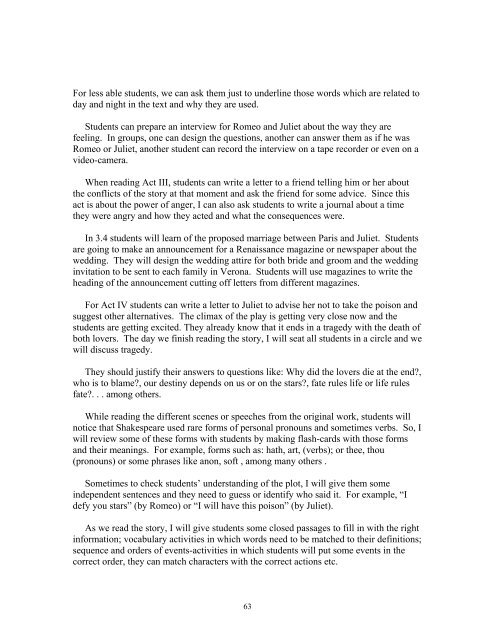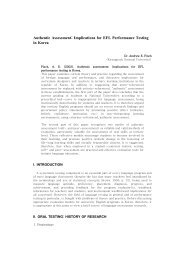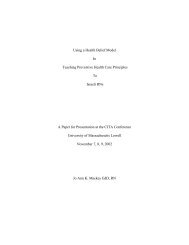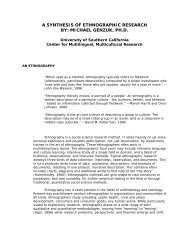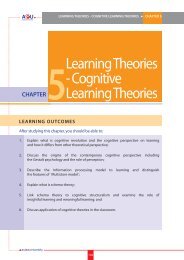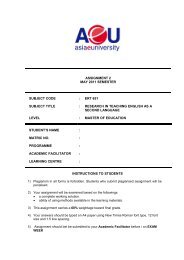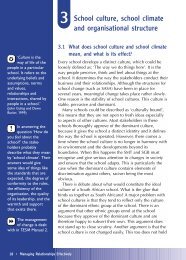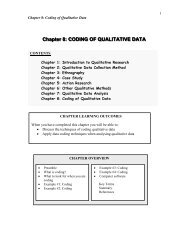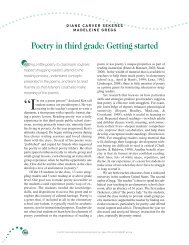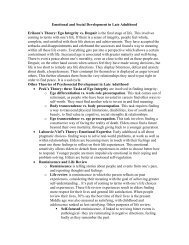Teaching Romeo and Juliet to ESL Students in ... - learningdomain
Teaching Romeo and Juliet to ESL Students in ... - learningdomain
Teaching Romeo and Juliet to ESL Students in ... - learningdomain
Create successful ePaper yourself
Turn your PDF publications into a flip-book with our unique Google optimized e-Paper software.
For less able students, we can ask them just <strong>to</strong> underl<strong>in</strong>e those words which are related <strong>to</strong>day <strong>and</strong> night <strong>in</strong> the text <strong>and</strong> why they are used.<strong>Students</strong> can prepare an <strong>in</strong>terview for <strong>Romeo</strong> <strong>and</strong> <strong>Juliet</strong> about the way they arefeel<strong>in</strong>g. In groups, one can design the questions, another can answer them as if he was<strong>Romeo</strong> or <strong>Juliet</strong>, another student can record the <strong>in</strong>terview on a tape recorder or even on avideo-camera.When read<strong>in</strong>g Act III, students can write a letter <strong>to</strong> a friend tell<strong>in</strong>g him or her aboutthe conflicts of the s<strong>to</strong>ry at that moment <strong>and</strong> ask the friend for some advice. S<strong>in</strong>ce thisact is about the power of anger, I can also ask students <strong>to</strong> write a journal about a timethey were angry <strong>and</strong> how they acted <strong>and</strong> what the consequences were.In 3.4 students will learn of the proposed marriage between Paris <strong>and</strong> <strong>Juliet</strong>. <strong>Students</strong>are go<strong>in</strong>g <strong>to</strong> make an announcement for a Renaissance magaz<strong>in</strong>e or newspaper about thewedd<strong>in</strong>g. They will design the wedd<strong>in</strong>g attire for both bride <strong>and</strong> groom <strong>and</strong> the wedd<strong>in</strong>g<strong>in</strong>vitation <strong>to</strong> be sent <strong>to</strong> each family <strong>in</strong> Verona. <strong>Students</strong> will use magaz<strong>in</strong>es <strong>to</strong> write thehead<strong>in</strong>g of the announcement cutt<strong>in</strong>g off letters from different magaz<strong>in</strong>es.For Act IV students can write a letter <strong>to</strong> <strong>Juliet</strong> <strong>to</strong> advise her not <strong>to</strong> take the poison <strong>and</strong>suggest other alternatives. The climax of the play is gett<strong>in</strong>g very close now <strong>and</strong> thestudents are gett<strong>in</strong>g excited. They already know that it ends <strong>in</strong> a tragedy with the death ofboth lovers. The day we f<strong>in</strong>ish read<strong>in</strong>g the s<strong>to</strong>ry, I will seat all students <strong>in</strong> a circle <strong>and</strong> wewill discuss tragedy.They should justify their answers <strong>to</strong> questions like: Why did the lovers die at the end?,who is <strong>to</strong> blame?, our dest<strong>in</strong>y depends on us or on the stars?, fate rules life or life rulesfate?. . . among others.While read<strong>in</strong>g the different scenes or speeches from the orig<strong>in</strong>al work, students willnotice that Shakespeare used rare forms of personal pronouns <strong>and</strong> sometimes verbs. So, Iwill review some of these forms with students by mak<strong>in</strong>g flash-cards with those forms<strong>and</strong> their mean<strong>in</strong>gs. For example, forms such as: hath, art, (verbs); or thee, thou(pronouns) or some phrases like anon, soft , among many others .Sometimes <strong>to</strong> check students’ underst<strong>and</strong><strong>in</strong>g of the plot, I will give them some<strong>in</strong>dependent sentences <strong>and</strong> they need <strong>to</strong> guess or identify who said it. For example, “Idefy you stars” (by <strong>Romeo</strong>) or “I will have this poison” (by <strong>Juliet</strong>).As we read the s<strong>to</strong>ry, I will give students some closed passages <strong>to</strong> fill <strong>in</strong> with the right<strong>in</strong>formation; vocabulary activities <strong>in</strong> which words need <strong>to</strong> be matched <strong>to</strong> their def<strong>in</strong>itions;sequence <strong>and</strong> orders of events-activities <strong>in</strong> which students will put some events <strong>in</strong> thecorrect order, they can match characters with the correct actions etc.63


